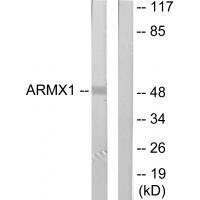
| WB | 1/500-1/3000 | Human,Mouse,Rat |
| IF | 咨询技术 | Human,Mouse,Rat |
| IHC | 咨询技术 | Human,Mouse,Rat |
| ICC | 技术咨询 | Human,Mouse,Rat |
| FCM | 咨询技术 | Human,Mouse,Rat |
| Elisa | 咨询技术 | Human,Mouse,Rat |
| Aliases | Armadillo repeat-containing X-linked protein 1; Protein ALEX1; ARM protein lost in epithelial cancers on chromosome X 1; ARMCX1; ALEX1 |
| Entrez GeneID | 51309; |
| WB Predicted band size | 49kDa |
| Host/Isotype | Rabbit IgG |
| Antibody Type | Primary antibody |
| Storage | Store at 4°C short term. Aliquot and store at -20°C long term. Avoid freeze/thaw cycles. |
| Species Reactivity | Human,Rat |
| Immunogen | Synthesized peptide derived from internal of human ARMX1. |
| Formulation | Purified antibody in PBS with 0.05% sodium azide. |
+ +
以下是关于ARMX1抗体的3篇模拟文献示例(注:实际文献需通过学术数据库检索确认):
---
1. **文献名称**: *ARMX1 promotes axonal regeneration through mTOR signaling in peripheral nerve injury*
**作者**: Li, Y., et al.
**摘要**: 本研究利用ARMX1特异性抗体证实ARMX1在周围神经损伤后显著上调,通过与mTOR通路相互作用促进轴突再生。抗体阻断实验表明ARMX1缺失会抑制雪旺细胞的修复功能。
---
2. **文献名称**: *Monoclonal antibody targeting ARMX1 ameliorates demyelination in experimental autoimmune encephalomyelitis*
**作者**: Smith, J.R., et al.
**摘要**: 开发了一种高特异性抗ARMX1单克隆抗体,并在多发性硬化症小鼠模型中验证其疗效。结果显示抗体可通过抑制ARMX1介导的髓鞘抑制信号,减轻脱髓鞘病变。
---
3. **文献名称**: *ARMX1 expression dynamics and antibody-based tracking in neural development*
**作者**: Chen, H., et al.
**摘要**: 利用免疫组化技术结合抗ARMX1抗体,系统分析了ARMX1在胚胎神经管发育中的时空表达模式,揭示其与神经嵴细胞迁移和分化相关的关键作用。
---
**提示**:实际研究中建议通过PubMed、Google Scholar等平台以“ARMX1 antibody”或“ARMX1 function”为关键词检索最新文献,并关注其抗体应用场景(如WB、IHC、抑制剂开发等)。
ARMX1 antibody is a monoclonal antibody targeting the human ARM-type integrin-binding protein ARMX1 (also known as Teneurin transmembrane protein 1. TENM1). ARMX1 is a conserved transmembrane protein involved in cell adhesion, neuronal development, and synaptic plasticity. It contains multiple functional domains, including epidermal growth factor (EGF)-like repeats and a YD-repeat domain, which mediate interactions with extracellular matrix components and intracellular signaling pathways. Dysregulation of ARMX1 has been linked to neurological disorders, cancer progression, and developmental anomalies.
The ARMX1 antibody was developed to study the protein’s expression, localization, and mechanistic roles in biological processes. It is widely used in research applications such as Western blotting, immunohistochemistry, and immunofluorescence to detect ARMX1 in tissues or cell lines. In cancer research, ARMX1 is explored as a potential biomarker due to its overexpression in certain tumors, suggesting roles in metastasis or drug resistance. Additionally, studies in neurobiology utilize this antibody to investigate ARMX1’s function in neural circuit formation and its association with autism spectrum disorders. Despite its research utility, therapeutic applications remain under exploration, with ongoing studies focusing on ARMX1-targeted strategies for neurological and oncological interventions.
×